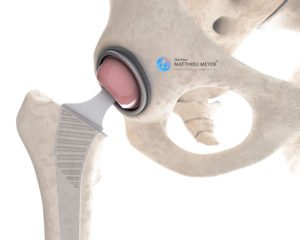Thanks to the technical advances, patients undergoing hip replacements are younger and more numerous. Consequently, the return to sports activities has become an important expectation right behind demand for pain relief and recovery of joint mobility.
A return to sports activities is possible after a hip replacement but depends on the type and intensity of the activity and is generally 2 to 3 months after the operation.
From a medical point of view, resuming sports activities offers psychological and cardiovascular benefits as well as improving muscle tone and endurance.
However, sport can engender complications: dislocation of the prosthesis (luxation), fracture of the bone around the prosthesis, acceleration of wear and loosening of the prosthesis, which is why some sports are not recommended after a hip replacement.
Several factors are taken into consideration to determine which sports are possible:
- Repeated impacts on the hip can, in some cases, accelerate the wear of the prosthesis and cause discomfort.
- The risk of falls, which may result in a fracture of the femur or pelvis and the loosening of the prosthesis. The patient’s experience in doing a high-risk sport will be taken into consideration in this case. For example, a good skier can consider skiing again whereas it would not be possible for a patient with little or no experience so as to avert fracturing the femur.
- The amplitude and type of movements required to prevent the dislocation of the prosthesis. This is particularly true in the first 6 months after the operation and primarily concerns patients for whom a posterior approach was used. The dislocation rate following an anterior approach is extremely low as the muscle and tendons are not sectioned.
The tables below provide indications of the sports that can be resumed after a hip replacement based on a survey of orthopaedic surgeons by the American Association of Hip and Knee Surgeons (AAHKS) and the French Society of Hip and Knee Surgery (Société Française de Chirurgie de la Hanche et du Genou (SFHG)).
| High-impact sports | Recommendation |
|---|---|
| Running | Not recommended |
| Squash | Not recommended |
| Martial arts | Not recommended |
| Football | Not recommended |
| Rugby | Not recommended |
| High-impact aerobics | Not recommended |
| Intermediate-impact sports | Recommendation |
|---|---|
| Singles tennis | Allowed (doubles recommended) |
| Downhill skiing | Allowed with experience |
| Snowboarding | Not recommended |
| Climbing | Allowed |
| Low-impact aerobics | Allowed |
| Stairclimber | Allowed |
| Weight-training equipment | Allowed |
| Roller skating / Ice skating | Allowed with experience |
| Mountain biking | Not recommended |
| Low-impact sports | Recommendation |
|---|---|
| Golf | Allowed |
| Swimming | Allowed |
| Cross-country skiing | Allowed with experience |
| Walking | Allowed |
| Exercise bike | Allowed |
| Elliptical trainer | Allowed |
| Road cycling | Allowed |
| Treadmill | Allowed |
| Off-piste skiing | Allowed with experience |
| Rowing | Allowed |
| Speed walking | Allowed |
| Dancing | Allowed |
| Pilates | Allowed |
However, active patients do not always follow these recommendations after undergoing surgery, with a third of them participating in high-impact sports including running, martial arts with blows or football and 70% of them reporting being little or not restricted by their hip during these activities.
This information is purely indicative and can be adapted in some cases; it is best to ask your surgeon who will give you further details.
Discover the operation linked to this article:

Minimally Invasive Anterior Approach Total Hip Replacement
Some pathologies such as hip osteoarthritis or necrosis of the femoral head can require a total hip replacement. A minimally invasive anterior approach can be used for this arthroplasty, which spares all the muscles and tendons thus enabling faster recovery and reducing the risk of dislocation of the prosthesis.

